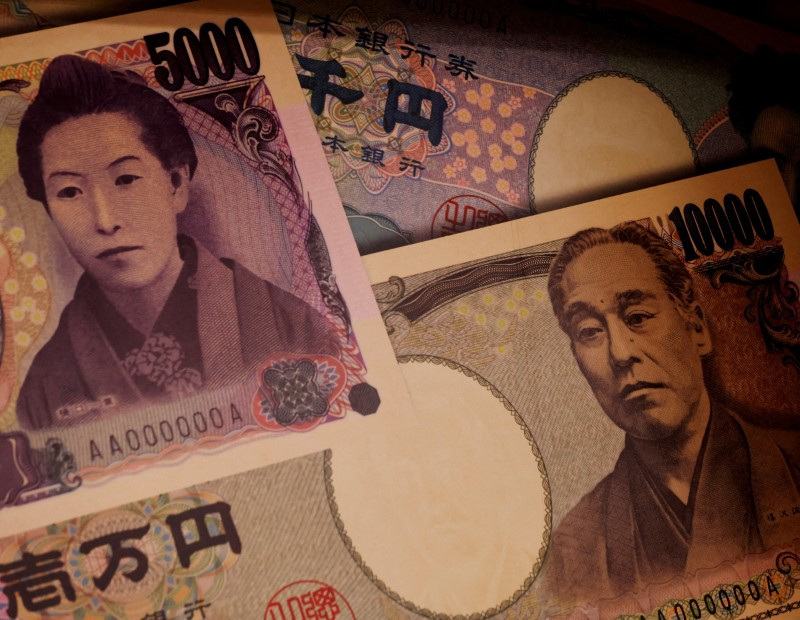By Ankur Banerjee
SINGAPORE (Reuters) – The yen was uneven on Thursday after a pointy drop within the earlier session in a unstable week that has left sentiment fragile as buyers weigh the unwinding of common carry trades and ponder the speed path Japan’s central financial institution is more likely to take.
The yen was final barely stronger at 146.09 per greenback, having dropped 1.6% on Wednesday after the Financial institution of Japan’s Deputy Governor Shinichi Uchida performed down the possibility of a near-term hike in rates of interest.
The Japanese forex began the week by scaling a seven-month excessive of 141.675 per greenback, a far cry from the 38-year lows it was rooted at in early July as comfortable U.S. jobs knowledge final week stoked recession worries and roiled buyers.
A shock hike from the BOJ final week additionally led buyers to bail out of carry trades, through which merchants borrow the yen at low charges to spend money on dollar-priced property for larger returns, serving to to elevate the yen.
A abstract of opinions voiced on the BOJ’s July coverage assembly confirmed on Thursday that some board members referred to as for the necessity to hold elevating rates of interest with one saying they need to ultimately be elevated to not less than round 1%.
The contrasting opinions from the abstract and Uchida on whether or not the BOJ will proceed to lift charges or pause because of market volatility, underscores the fragile process going through the central financial institution and can probably hold buyers skittish.
“While the BOJ may have paused for now, it is likely to continue its journey towards normalizing policy in the coming months,” stated Vasu Menon, managing director of funding technique at OCBC.
“It may be too early to pop the champagne as markets remain vulnerable to the risk of negative news flows and other global uncertainties.”
ANZ Financial institution’s chief economist Sharon Zollner and strategist David Croy identified that even when the Federal Reserve cuts charges by as a lot as markets are pricing in and the BOJ hikes once more, Japanese charges will nonetheless be nicely under their U.S. equivalents.
“So, the carry trade isn’t likely to end any time soon, but we may see more dollar/yen movement as investors trim risk positions,” they stated in a be aware.
The Swiss franc, one other forex that was used to fund carry trades, was barely stronger at 0.8606 per greenback, after an over 1% drop within the earlier session.
DEFENSIVE DOLLAR
The sharp strikes within the yen has pushed the , which measures the U.S. forex in opposition to six rivals together with the yen, to 103.08, close to the seven-month low of 102.15 it touched on Monday.
The euro was regular at $1.09285, whereas sterling final fetched $1.26865, hovering near the one-month low it touched on Tuesday.
Merchants anticipate the Fed to chop charges by 50 foundation factors at its subsequent assembly in September because the financial system slows, however they’re additionally pricing in a 26.5% probability of a smaller 25 bps discount, based on the CME Group’s (NASDAQ:) FedWatch Instrument.
On Monday, that they had at one level totally priced in a 50-bps lower and had even began pricing in the potential for an emergency charge discount earlier than the September assembly, although these odds have eased since then as markets stabilise considerably.
Investor focus will now be on the U.S. client value inflation report for July due subsequent week in addition to feedback by Fed Chair Jerome Powell on the central financial institution’s Jackson Gap Financial Coverage Symposium on Aug. 22-24.

“Investors need to brace for a bumpy ride,” stated OCBC’s Menon, noting that there’s nonetheless one other six weeks earlier than the subsequent Fed assembly and “there is a lot of economic data on tap between now and then which could change the odds”.
The Australian greenback was 0.14% larger at $0.65275, whereas the New Zealand greenback was regular at $0.59985.



